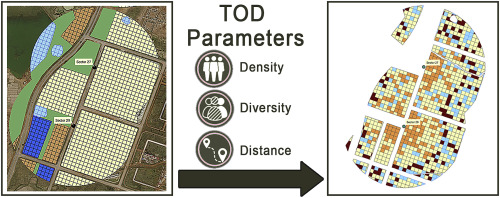Journal of Environmental Management ( IF 8.0 ) Pub Date : 2017-12-29 , DOI: 10.1016/j.jenvman.2017.12.004 Akshay Sahu

|
Developing nations are adopting transit oriented development (TOD) strategies to decongest their transportation systems. These strategies are often adopted after the preparation of land use plans. The goal of this study was to build a methodology to modify these land uses using soft computing. This can help to achieve alternate land use plans relevant to TOD. The methodology incorporates TOD characteristics and objectives. Global TOD parameters (density, diversity, and distance to transit) were studied. Expert opinions gave weights and ranges for the parameters in an Indian TOD scenario. Rules to allocate land use was developed. Objective functions were defined. Four objectives were used. First was to maximize employment density, residential density and percent of mix land use. Second was to shape density and diversity with respect to distance. Third was to minimize degree of land use change, and fourth was to increase compactness of the land use allocation. The methodology was applied to two sectors of Naya Raipur, the new planned administrative capital of the state of Chhattisgarh, India. The city has implemented TOD in the form of Bus rapid transit system (BRTS) over an existing land use. Thousand random plans were generated through the methodology. Top 30 plans were selected as parent population for modifications through genetic algorithm (GA). Alternate plans were generated at the end of GA cycle. The best alternate plan was compared with successful BRTS and TOD land uses for its merits and demerits. It was also compared with the initial land use plan for empirical validation.











































 京公网安备 11010802027423号
京公网安备 11010802027423号